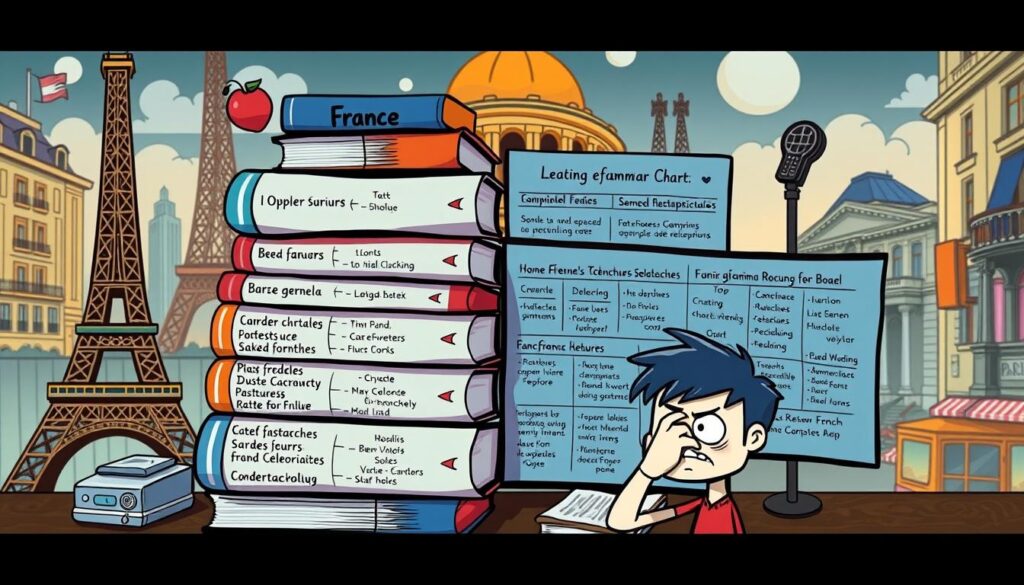Many wonder if learning French is easy or hard for Filipino speakers. Your path to learning French as a Filipino may use your knowledge of English and Spanish. The Philippines’ 187 dialects offer a wide base, helping you learn new languages.
French comes from Latin and is spoken in 29 countries, similar to Spanish. This might make French easier for Filipinos to learn. But, French has different pronunciation and more vowel sounds than Tagalog’s five. And, unlike Tagalog’s VSO, French uses SVO, making it a bit hard at first. Plus, French nouns have genders, and there are many pronouns to learn.
Yet, knowing English helps Filipinos due to shared cognates with French. This makes learning French vocabulary easier than one might think. Also, by exploring French culture—its literature, movies, and music—you get better at the language. So, to answer if learning French is easy, visit this link for more information.
Understanding the Filipinos’ Linguistic Background
The Philippines is a haven of languages, with over 170 spoken across its islands. This multilingual setting lets Filipinos easily pick up new languages. Learning French fits right into their rich tradition of language.
Filipino and English dominate in schools and official work. But many also speak local tongues like Cebuano, Ilocano, and Hiligaynon from childhood. This early multilingual exposure helps them learn new languages more comfortably.
The Bilingual and Multilingual Nature of Filipino Speakers
Filipinos switch between languages with ease, boosting their language learning. In cities, it’s normal to mix English and Filipino in chats. In the provinces, folks often pair a local dialect with Filipino or English. This shows Filipinos’ amazing language skills.
Impact of Spanish Colonization on Filipino Languages
Spanish has deeply influenced the Filipino language, with nearly half of Tagalog’s words having Spanish roots. This makes learning Spanish and related languages easier for Filipinos. Yet, many are now keen on learning French, showing a willingness to explore beyond familiar languages.
Learning French: A Step Beyond English and Filipino Proficiency
Learning French is a bold step for Filipinos. French is different from Filipino and Spanish in structure and vocabulary. This means facing new linguistic challenges and cultural details. Yet, Filipinos’ solid language foundation helps them in mastering French.
| Language | Primary Speakers (million) | Total Speakers including second language (million) |
|---|---|---|
| Filipino | 28 | 100 |
| Cebuano | 22 | 22 |
| Ilocano | 8 | 8 |
| Hiligaynon | 9 | 9 |
| English | 0.2 | 55 |
Filipinos’ ability to juggle many languages is impressive. It not only shows the range of languages in the Philippines but also their openness to learn more. French is a new path for them to explore more cultures and languages.
Is French Easy to Learn for Filipino
If you’re digging into language study, specifically Study French for Filipinos, understanding how the native Philippine languages affect this learning is key. Many Filipinos, thanks to being bilingual or multilingual, have a good starting point for learning French language fluency for Filipinos.
The ease of learning French for Filipinos largely depends on their experience with other languages. A big chunk of English words—about one-third—comes from French. This connection helps Filipinos familiar with English to learn French more easily. Moreover, Tagalog includes many Spanish words, making up about 25% of its vocabulary. Since Spanish and French share linguistic roots, this also makes French vocabulary and grammar easier to grasp for Filipinos.
However, challenges exist, notably in pronunciation and grammar, such as gendered nouns and varying accents. For insights into how long it might take Filipinos to master French, check out this study on how many hours it takes to learn.
To add, comparing the understanding between languages with common features shows:
| Language | Ease for Speakers (due to Similar Languages) |
|---|---|
| Tagalog | Easier for Spanish speakers |
| Haitian Creole | Easier for French speakers |
| Japanese | Simple pronunciation aids learners |
| Spanish | Orthography aids pronunciation |
Being exposed to several languages early on might make Filipinos more adaptable when learning French. So, the path to study French for Filipinos could be smoother thanks to their multilingual background.
Key Challenges for Filipinos Learning French
Filipinos face unique hurdles in learning French. Pronunciation, grammatical detail, and verb conjugation are tough areas. Let’s dive deeper into these challenges below.
Navigating Pronunciation Differences
Mastering French pronunciation is tough for Filipinos. This is due to unfamiliar sounds that don’t exist in Tagalog or English. The French language has silent letters and distinctive nasal vowels. Pronouncing letters like “r” and “u” presents a challenge. Unlike Filipino languages, French phonetics are less predictable. It’s crucial to grasp accents like cédille (ç) and aigu (é). They change word meanings, affecting communication.
Grasping Gendered Nouns and Articles in French
Gendered nouns add complexity for Filipino speakers of French. French nouns are categorized as masculine or feminine. This affects related articles and adjectives. Unlike Tagalog, these concepts are foreign to Filipinos. It makes learning challenging.
Conjugation and Grammatical Structures Distinct from Tagalog
Conjugation is tough for Filipinos learning French. Verb forms change with the subject, tense, and mood. French verbs have many forms, unlike Filipino verbs. Mastering conjugations is key for communication. It’s a big challenge for most Filipino learners.
Cultural Affiliation and Interest in the French Language
The French language draws people with its title as the language of love. This charm, alongside rich French culture and literature, drives Filipinos towards it. For them, learning French opens up global conversations and opportunities.
The Romantic Appeal of French Language
Learning French isn’t only about the grammar and words. It’s a way to connect with a language known for romance and elegance. The beauty of French motivates people. This makes learning resources for Filipinos essential to capture the language’s essence.
Filipino Fascination with French Culture and Literature
Filipinos are deeply interested in French culture and literature. They want to dive into France’s cuisine, fashion, and writings. Resources that give cultural insights make learning French more fun and full.
Below is a table reflecting the participation of Filipino learners in French courses, their motivations, and their preferences in language learning, which underscores the growing interest in French culture and language among Filipinos.
| Language Studied | Percentage | Key Motivation |
|---|---|---|
| Chinese | 17.3% | Career Enhancement |
| French | 26.7% | Cultural Affiliation |
| Japanese | 33.3% | Economic Opportunities |
| Spanish | 22.7% | Communication |
This chart shows why French is popular compared to other languages. It points out why Filipinos pick French, focusing on cultural reasons. These insights help educators and online platforms to offer more relevant French learning resources for Filipinos.
The Berlitz Method and Learning French for Filipinos
Learning French is more than just understanding words and grammar for many Filipinos. It’s about having conversations that help solidify the language. The Berlitz Method for learning French is perfect for this. It focuses on practical use rather than just theory.
This method makes sure students actively use the language. They engage in structured dialogues that feel like real-life. This way, they quickly learn to converse in French, moving towards fluency.
The Berlitz Method can be tailored to any level. It doesn’t matter if you’re starting out or looking to improve. It’s a great choice for learners in the Philippines wanting effective results.
However, committing to this method is key. Continuous practice and engagement are necessary. Filipino learners must dive into the French language. It might seem hard at first, but this method makes it easier with its practical focus.
If you’re curious about language learning techniques and how they stack up against the Berlitz Method, check out this guide.
In conclusion, the Berlitz Method for learning French offers Filipinos a strong way to learn. It’s all about conversational learning. With dedication, learners will overcome challenges and enjoy being fluent in a new language.
French Language Learning Experiences in Alliance Française de Manille
Learning French in the Philippines offers a mix of exciting opportunities and challenges. The Alliance Française de Manille shines as a guide for language lovers. It welcomes students of all levels, from complete beginners to advanced learners. With its global presence, including in the Philippines, it provides a rich French learning experience.
Known for its excellence, Alliance Française de Manille focuses on giving each student personal attention. This method helps with the tough parts of learning French. Things like pronunciation, gendered nouns, and verb conjugations can be tricky. The Filipino context, with its many dialects, adds to the challenge. But AFM’s teaching methods make learning French engaging and effective.
Getting to B1 level in French lets you understand the main ideas of clear conversations on familiar topics. Starting at AFM costs about P7,000. This includes all you need to start and a one-year membership. This investment puts you part of a long tradition of excellence. It’s suitable for everyone, whether you’re from Metro Manila or a region with different dialects. Learning French at AFM boosts your skills and enriches the French educational experience in the Philippines.


